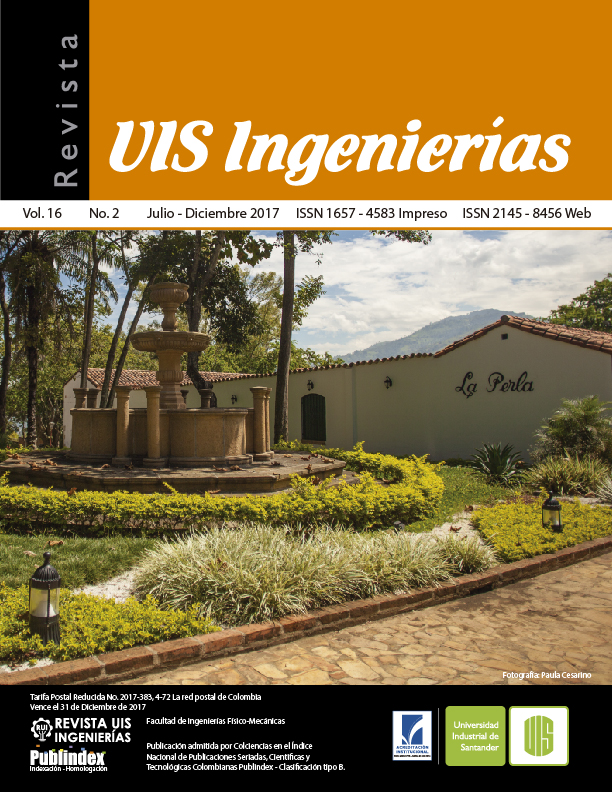Assessment of the cogeneration potential of a 10 kVA diesel electric generator set
Published 2017-07-31
Keywords
- Energy balance,
- Combustion engine,
- Generator group
How to Cite
Abstract
Since the combustion engine based electrical generation has an important share in the total electrical energy produced by the country, the assessment of opportunities of autogeneration is seen as a needed strategy in the seek of reduction of energy consumption and the mitigation of environmental impact derived from the use of internal combustion engines. It is the purpose of the present work to disclose the engine energy balance composition and to depict some basic parameters for the cogeneration assessment of combustion engine based generator sets. The concepts presented in the paper are illustrated with the experimental measurements taken in a 10 kVA two cylinder Diesel engine based generator, tested under three load conditions given by a corresponding number of cooled electrical resistances. Measurements of fuel consumption, consumed electrical power, and heat evacuated with exhaust gases and coolant are used to calculate the thermal energy balance of the Diesel engine as well as the cogeneration potential of the generator set.
Downloads
References
- Ley 1215 de 2008. Por la cual se adoptan medidas en materia de generación de energía eléctrica. Diario Oficial 47052 de Colombia. Julio 16 de 2008.
- Resolución 085/1996. Comisión Reguladora de Energía y Gas, CREG. Cogenerador conectado al SIN. Bogotá: Ministerio de Minas y Energía, 1996.
- Capacidad instalada de autogeneración y cogeneración en sector de industria, petróleo, comercio y público del País. Informe presentado por el consorcio HART-RE a la Unidad de Planeación Minero Energética, UPME, diciembre 22 de 2014. Disponible en http://www.andi.com.co/cgc/Documents/1_Informe_final_auto_cogeneracion.pdf.
- Resolución CREG 005 de 2010. Por la cual se determinan los requisitos y condiciones técnicas que deben cumplir los procesos de cogeneración y se regula esta actividad.Comisión Reguladora de Energía y Gas, CREG, 2010.
- Ley 1715 de 2014. Por la cual se regula la integración de las energías renovables no convencionales al Sistema Energético Nacional. Diario Oficial de Colombia No. 49.150. Mayo 13 de 2014.
- Decreto 2469 de 2014. Lineamientos en materia de entrega de excedentes de autogeneración. Ministerio de Minas y Energía, MME, 2014.
- Resolución CREG 024 de 2015. Regulación de la actividad de autogeneración a gran escala en el Sistema Interconectado Nacional (SIN). Comisión Reguladora de Energía y Gas, CREG, 2015.
- Resolución 0281 de 2015. Definición del límite de autogeneración de pequeña escala. Unidad de Planeación Minero Energética, UPME, 2015.
- Decreto 2143 de 2015. Incentivos para promover las inversiones en Fuentes No Convencionales de Energía (FNCE) y la gestión eficiente de la energía contenidos en el Capítulo III de la Ley 1715. Ministerio de Minas y Energía, MME, 2015.
- H. I. Onovwiona, and V. I. Ugursal. “Residential cogeneration systems: review of the current technology”. Renewable and Sustainable Energy Reviews 10(5), 2006, 389-431.
- IEA, International Energy Agency. World Energy Outlook 2016, Resumen Ejecutivo.
- Reciprocating Engines (DOE CHP Technology Fact Sheet Series) – Fact Sheet, 2016: https://energy.gov/sites/prod/files/2016/09/f33/CHP-Recip%20Engines.pdf.
- T. Morel and R. Keribar. “Heat radiation in D. I. Diesel engines”, SAE paper 860445, 1986.
- T. Morel et al. “Methods for heat analysis and temperature field analysis of the insulated Diesel”, NASA CR-174783, 1984.
- I. Taymaz, I. “An experimental study of energy balance in low heat rejection diesel engine”, Energy 31, 2006.
- G.Descombes, F. Maroteaux and M. Feidt. “Study of the interaction between mechanical energy and heat exchanges applied to IC engines”, Appl. Therm. Eng., vol. 23, issue 16, 2003, pp. 2061-20078.
- J. A. Caton. “A review of investigations using the Second Law of Thermodynamics to study internal combustion engines”, SAE paper 2000-01-0952, 2000.
- J.B. Heywood, “Internal combustion engine fundamentals”, Mc-Graw Hill, 1988.
- Romero, P. C. Máquinas de combustión interna. Fundamentos de construcción y cálculo. UTP, 2003.
- Romero, P. C. Contribución al Conocimiento del Comportamiento y la Gestión Térmica de los Motores de Combustión Interna Alternativos. Tesis Doctoral, CMT-UPV, Valencia, España, 2009.
- A.J. Torregrosa et al. “Assessment of the influence of different cooling system configurations on engine warm-up, emissions and fuel consumption”, IJAT, vol. 9, nº 4, pp. 447-458, 2008.
- European Renewable Energy Council, EREC. “Creating Markets for Renewable Energy Technologies EU RES Technology Marketing Campaign. Documento derivado del proyecto RESTMAC”. Disponible en http://www.energy-cities.eu/IMG/pdf/RESTMAC_-_Cogeneration_at_Small_Scale.pdf.
- H. Perez-Blanco, “Experimental characterization of mass, work and heat flows in an air cooled, single cylinder engine”, Energy conversion and management 45, 2004.

